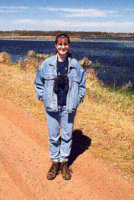Effects of West Nile Virus Infection, Immune Function, and Age on Female Yellow-headed Blackbird (Xanthocephalus xanthocephalus) Reproduction.

Jennifer L. Newbrey (PhD Student)
Department of Biological Sciences
Email: Jennifer.Newbrey@ndsu.edu
Degrees:
2002 - M.S. Univ. of Wisconsin – Stevens Point, Natural Resources: Wildlife
1997 - B.S. Univ. of Wisconsin – Stevens Point, Wildlife and Biology
Fellow: Jennifer L. Newbrey, Department of Biological Sciences, NDSU
Advisor: Wendy L. Reed, Assistant Professor of Zoology, NDSU
Matching Support: NDSU
Degree Progress: Ph.D. expected in December 2006.
Effects of West Nile Virus Infection, Immune Function, and Age on Female Yellow-headed Blackbird (Xanthocephalus xanthocephalus) Reproduction.
Recent high water levels in the Missouri Coteau region of North Dakota have resulted in increased aquatic habitats for wetland breeding birds and mosquitoes. Because birds often serve as intermediate hosts for the mosquito borne West Nile virus (WNV), increased populations of birds and mosquitoes could impact the ecology, rate of emergence, and persistence of the disease in humans and wildlife. The recent spread of WNV into the state has produced the need for research to study the influence of the virus on North Dakota’s wildlife. Avian WNV research can also provide insight into the potential for birds to serve as WNV infection reservoirs for the human population and other species.
The North Dakota Department of Health reported the first cases of WNV in the state in the summer of 2002. The first bird to test positive for WNV was a crow found on July 14th, and the first positive human cases were reported on August 28th. Because stagnant water in wetlands is ideal breeding habitat for mosquitoes, wildlife associated with these habitats may suffer high rates of WNV infection. The recent arrival of WNV into the state necessitates a study of the prevalence and immunological impact of WNV on native North Dakota wetland species. Most research on the virus has focused on using carcasses of birds as a surveillance system for detecting the spread of WNV across North America. No published research has been conducted on a living population of free-ranging birds to determine the non-lethal effects of the virus. Failure of biologists to adequately address disease emergence in free-ranging wildlife may lead to diminished geographic distributions and populations declines.
The Missouri Coteau region of central North Dakota has many small prairie wetlands, which provide essential foraging and breeding habitat for many species of birds. Yellow-headed blackbirds (Xanthocephalus xanthocephalus) are an ideal species to study WNV infection because they breed in high-density wetland colonies throughout the Coteau. Establishing rates of WNV infection in yellow-headed blackbirds is necessary to determine the vulnerability of this wetland dwelling species and to predict potential impacts of the virus on other species of wetland birds.
Objectives and Methods:
The overall objective of this project is to determine the effects of female age and infection with WNV on yellow-headed blackbird reproduction. The specific objectives of this project are to 1.) identify the prevalence of WNV in a free-living population of yellow-headed blackbirds, 2.) to quantify variation in immune function of female blackbirds, and 3.) to measure the relationship between female immune function and age on carotenoid (i.e., biologically active yolk pigments that protect developing embryos against DNA, protein, and lipid damage) allocation to eggs.
Female yellow-headed blackbirds will be captured to collect blood samples to assess WNV antibody production, to measure variation in immune function using non-lethal immune challenges, and to determine female age. Prior to release, each female will be banded with a standard Fish and Wildlife Service aluminum band along with a unique color-band combination for individual field identification. I will locate and monitor nests of marked females to monitor reproductive success of each female. The third-laid egg will be collected from each nest for carotenoid analysis and WNV antibody detection.

Project Progress:
During my first field season in 2003, I collected third-laid eggs from 51 female yellow-headed blackbirds on 7 different wetlands. I captured 20 female yellow-headed blackbirds and collected blood and feather samples for WNV antibody detection and carotenoid analysis. I also collected blood samples from 9 male yellow-headed blackbirds, 19 grackles, and 2 red-winged blackbirds to use for WNV detection. I conducted immune challenges on 5 females, but the majority of the immune data will be collected in upcoming field seasons. I am currently in the process of setting up our lab to detect WNV in avian blood and yolk samples.
I have been invited to give a talk on my research at the Entomological Society of Manitoba meetings on October 24, 2003.
Significance of Research:
This study will provide essential information on the prevalence and immunological impact of WNV on a North American avian species. Infection with the virus can be lethal, however, the degree to which birds are adversely affected varies across species and even between individuals within a species. By testing for the presence of antibodies to WNV in yellow-headed blackbirds, I will be able to assess the vulnerability and degree of virus exposure in a free-living population of wetland dwelling birds. I will also be able to evaluate potential influences of current high-water conditions on breeding populations of mosquitoes and avian WNV infection rates.
Many wildlife pathogens cause non-lethal physiological and reproductive effects that remain poorly understood. This study will quantify the immunological costs and maternal tradeoffs associated with exposure to a non-lethal antigen. Because female birds allocate essential resources to eggs, exposure to pathogens can shift maternal resources away from reproduction. This seemingly small, non-lethal effect influences the survival of offspring and can therefore cause population level effects in the next generation.
Jennifer L. Newbrey, 2003. Presentation to the NDWRRI Advisory Committee

Wendy Reed
Biological Sciences


